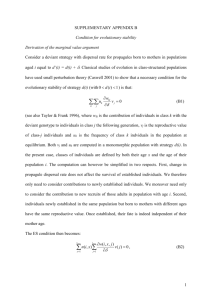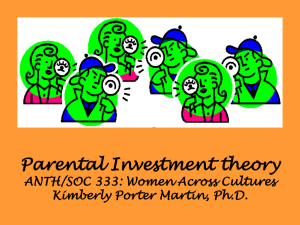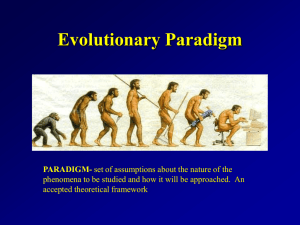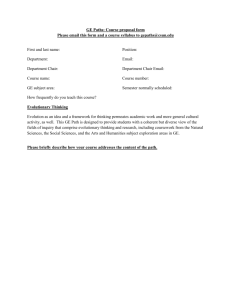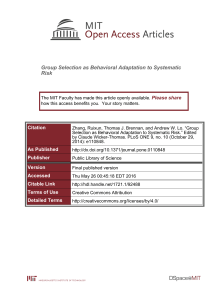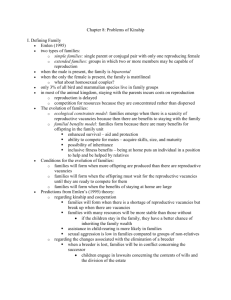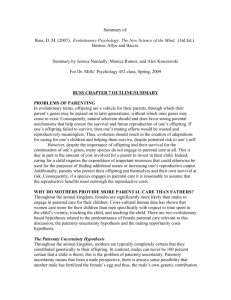Barrett et al TOC
advertisement
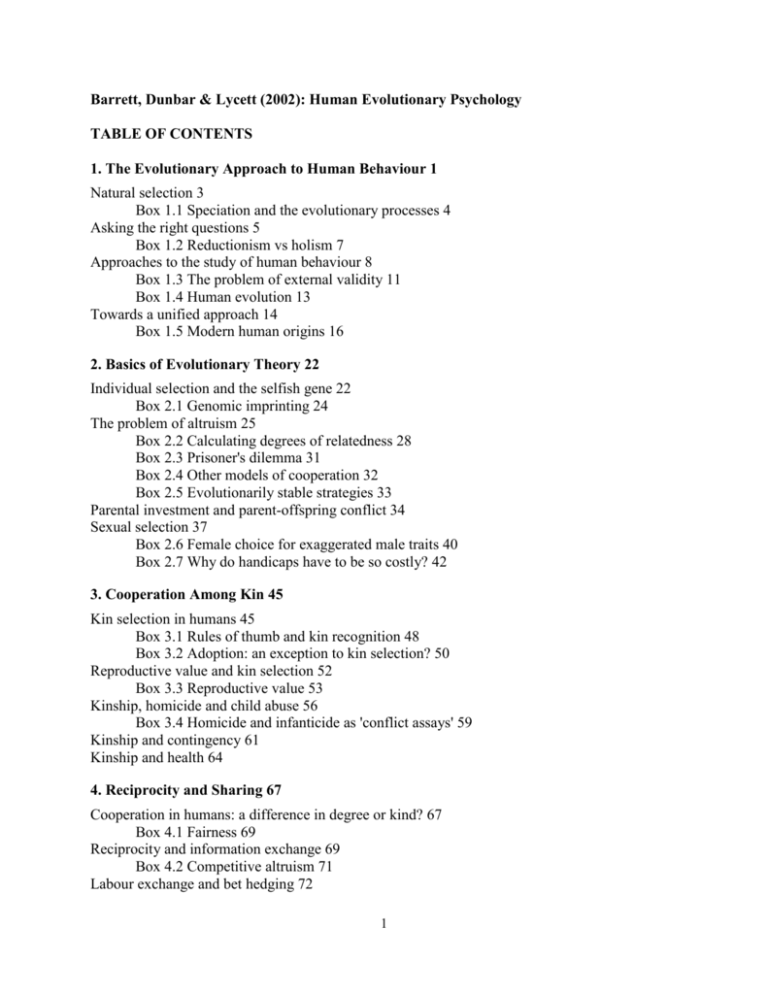
Barrett, Dunbar & Lycett (2002): Human Evolutionary Psychology TABLE OF CONTENTS 1. The Evolutionary Approach to Human Behaviour 1 Natural selection 3 Box 1.1 Speciation and the evolutionary processes 4 Asking the right questions 5 Box 1.2 Reductionism vs holism 7 Approaches to the study of human behaviour 8 Box 1.3 The problem of external validity 11 Box 1.4 Human evolution 13 Towards a unified approach 14 Box 1.5 Modern human origins 16 2. Basics of Evolutionary Theory 22 Individual selection and the selfish gene 22 Box 2.1 Genomic imprinting 24 The problem of altruism 25 Box 2.2 Calculating degrees of relatedness 28 Box 2.3 Prisoner's dilemma 31 Box 2.4 Other models of cooperation 32 Box 2.5 Evolutionarily stable strategies 33 Parental investment and parent-offspring conflict 34 Sexual selection 37 Box 2.6 Female choice for exaggerated male traits 40 Box 2.7 Why do handicaps have to be so costly? 42 3. Cooperation Among Kin 45 Kin selection in humans 45 Box 3.1 Rules of thumb and kin recognition 48 Box 3.2 Adoption: an exception to kin selection? 50 Reproductive value and kin selection 52 Box 3.3 Reproductive value 53 Kinship, homicide and child abuse 56 Box 3.4 Homicide and infanticide as 'conflict assays' 59 Kinship and contingency 61 Kinship and health 64 4. Reciprocity and Sharing 67 Cooperation in humans: a difference in degree or kind? 67 Box 4.1 Fairness 69 Reciprocity and information exchange 69 Box 4.2 Competitive altruism 71 Labour exchange and bet hedging 72 1 Food sharing among hunter-gatherers 72 Box 4.3 The marginal value theorem and tolerated theft 77 Box 4.4 The tragedy of the commons 85 Are humans inherently selfish? 86 Box 4.5 How 'selfish' genes lead to non-selfish people 90 5. Mate Choice and Sexual Selection 93 Universal principles of mate choice 94 Box 5.1 Anisogamy 95 Box 5.2 Lonely hearts advertisements: methodological considerations 97 Box 5.3 Evolution of pairbonding 104 Sexually selected traits 105 Box 5.4 WHR and body mass index 109 Box 5.5 The problem of concealed ovulation 112 Conditional mate choice strategies 118 Courtship 122 Fitness consequences of mate choice 126 Box 5.6 Changes in bridewealth among the Kipsigis 128 6. Life-history Constraints and Reproductive Decisions 137 Optimising family size 137 Box 6.1 Why do humans have such large brains? 139 Box 6.2 Why are human babies born so early? 141 Box 6.3 Impact of offspring production on parental survival 143 Box 6.4 Optimality models and stochastic dynamic programming 146 Box 6.5 Are !Kung birth rates low by accident rather than design? 148 Scheduling reproduction 150 For love or money 154 The demographic transition 158 The evolution of menopause 164 Box 6.6 Phenotypic correlations 165 Box 6.7 Celibacy and homosexuality 168 7. Parental Investment Strategies 171 Conflict in the womb 171 Parental biases and sibling rivalry 172 Box 7.1 Pregnancy sickness and parent-offspring conflict 173 Box 7.2 Teaching biases and peer groups 175 Box 7.3 Family environment and future reproductive strategies 176 Infanticide: scheduling investment 178 Box 7.4 Paternity certainty and sexual jealousy 182 Selective infanticide and the sex ratio 188 Box 7.5 Testing the Trivers-Willard hypothesis 192 Condition-dependent investment strategies 194 2 8. Marriage and Inheritance 203 Matrilineal vs patrilineal inheritance 204 Box 8.1 Marriage and inheritance: a phylogenetic analysis 205 Box 8.2 Environmental correlates of polygyny 206 Resource competition and lineage survival 209 Box 8.3 Wealth-dependent herd management 213 Keeping it in the family: incest and marriage rules 221 Box 8.4 The Westermarck effect 222 Box 8.5 Incest and exogamy 225 Tibetan polyandry 224 Box 8.6 The member-joiner game 228 Box 8.7 Reproductive rivalry and the risk of fission 233 9. The Individual in Society 235 Kinship and kinship-naming 236 Sex biases in social organisation 240 Structure of social groups 244 Box 9.1 Self-structuring principles for societies 248 Box 9.2 Evolutionary history of society 252 The freerider problem 253 Box 9.3 How dialects control freeriders 260 Society, violence and warfare 260 Box 9.4 How not to do evolutionary analyses 263 Box 9.5 When does it pay to go berserk? 264 Box 9.6 Evolutionary explanations of rape 266 10. Cognition and the Modular Brain 270 A brief history of modularity 271 Box 10.1 Mental models: error-prone biases or simple rules that make us smart? 274 'Beyond modularity' 276 Box 10.2 'Fast-and-frugal' algorithms 278 Social exchange and cheat detection 281 Box 10.3 The Wason selection task 282 Box 10.4 Relevance theory and the selection task 286 The role of emotions 288 Box 10.5 Neurobiology of social reasoning 290 11. Social Cognition and its Development 295 Theory of mind 296 Box 11.1 Intentionality 297 Box 11.2 Theory theory 298 Development of theory of mind 300 Box 11.3 False belief task: a benchmark for theory of mind? 305 Box 11.4 Theory of mind in adults 307 When ToM fails 309 3 Box 11.5 Theory of mind and clinical disorders 315 The social brain 316 12. Language 322 The evolution of language 323 Box 12.1 How many people can you talk to? 326 Box 12.2 When did speech evolve? 330 Box 12.3 The evolution of languages 333 The social functions of language 334 Box 12.4 An instinct for gossip? 337 Language and meaning 342 Cognitive underpinnings 344 Box 12.5 Motherese 345 Box 12.6 Laughter and social bonding 346 13. Cultural Evolution 351 What is culture? 352 Box 13.1 Psychological mechanisms of cultural transmission 353 Box 13.2 How memes differ from genes 356 Is culture adaptive? 361 Box 13.3 The evolution of fantasy 362 Cultural evolution under neutral selection 367 Box 13.4 The evolution of the teddy bear 368 Processes of cultural evolution 370 Box 13.5 Two examples of gene-culture co-evolution 372 How fast does culture change? 375 Box 13.6 What happens when cultural change is too slow? 377 Culture change and group selection 379 4


